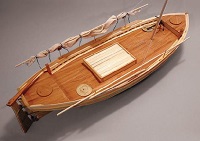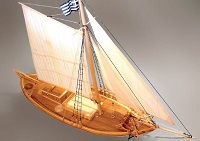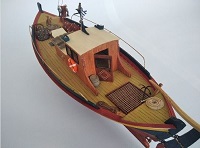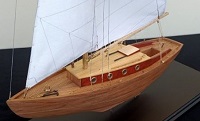Navarino Models
 |
| Naam | Omschrijving | Afbeelding |
|---|---|---|
| Chaniotiki Gaita | At the beginning of the 20th century, in Chania Crete, boats which had special features were built and which had a total length of up to 10 metres. Some of these boats exist till this date. The fore and aft cutwater were straight, and there was a small wedge placed at the top part of the stern, onto which the rear ends of the railings were fixed, thus creating more usable space in the rear area of the deck. In general, the vessel was wide and shallow. The deck's intense camber and the arched upper tip of the wedge (koroni) are two characteristics of the chaniotiki gaita. The rudder was wider than that of other boats and the stern protruded far enough so as to support its weight. The last samples of this type, bear a small and angled mast and the square sail's yard. SCALE 1/24 - LENGTH 335MM Van deze boot is er een tijdschrift artikel [of meer dan 1] te vinden op de pagina Modellen Tijdschrift Artikelen [Deze pagina is alleen toegankelijk voor VMBC het Anker leden] |  |
| Trechantiri | Trechantiri is one of the most loved,seaworthy and genuine Greek vessels. The word Trechantiri may owe its origin to the word trohantiras which has been found in texts of 9th & 10th century Byzantine writers and it means podostama. The vessel was first built in the mid 17th century. Its length reached 25 - 30 m. One of its characteristics was the shape of its stem post, which ends in a type of head.Another characteristic was its pointed stern post, which is almost a straightline. This vessel was and is used in almost all areas of marine activity. It is most frequently used by professional fishermen, although in the past it was also used as a merchant vessel and as a sponge collecting vessel. Nowadays, it is more popular as an entertainment vessel as opposed to a professional fishingboat. The Trechantiri is believed to have originated in Hydra, although this fabulous vessel was and still is constructed in Syros, Kavala, Samos,Perama et al. The fact that it is very wide compared to its length is the main reason for its remarkable stability in combination with the formation of the bow, the stern and its curved timber. Thus, it is regarded as one of the most sea worthy vessels for crossing the often rough Greek seas. It is the type of boat which continues being constructed in the Aegean. Most of the Trechantiri built nowadays have a total length of 8-15 m. It is said that the Trechantiri originates from trampakoulo, a traditional vessel of the Adriatic. The most striking characteristic of its hull is the curved shape of the bow , which exhibits some changes especially regarding its angle of inclination & its curviture. SCALE 1/35 - LENGTH 478MM |  |
| Fishing Trechantiri | SCALE 1/20 - LENGTH 550MM |  |
| Cargo ship 1938 Brockley Combe | Brockley Combe was a British cargo ship which was built by Hill Charles & Sons in their Bristol Shipyard, in 1938. She was a typical example of a dry load cargo ship of the age and was 56.2m long. Her power came from a diesel engine. Her career came to a sad end on 15th December 1953, when she broke up and sank after running agroynd south of Jersey, on the islands known as Minquiers. SCALE 1/72 - LENGHT 730MM |  |
| Sailing Yacht | SCALE 1:16. L.O.A.: 470MM |  |
| Monoreme Pentikontoros | In the pre-classic period the ships that travelled through the region of the Mediterranean Sea, according to findings of shipwrecks, as well as information from ancient texts, were built by the method "shell first". After the initial attempt to build canoes and papyrella, evolution in shipbuilding came in the form of "shell first". This technique can be described as follow: The shipwrights of the time, cut tree trunks and they formed them in order to get the desired shape. Then they connected the next shaped trunk using wood mortises and tenons. The reason that they did not use metal for the joining process, is obviously that it was expensive to create nails or not yet aware of the forging process. Thus, all separate elements functioned as a solid component which was getting the tolerances and strength of the raw wood. At the final stage of construction, shipwrights, insulates the hull of the vessel with tar and freeboard with tallow. This technique was maintained until the mid-Byzantine period, where the cost (materials and labor), became unprofitable. The types of vessels in that period were two: The strongylai (sort ) and the long ships. The first type mainly involved commercial vessels (Kyrenia Trade ship) and the second type included naval designs for longer trips and expeditionary purposes. Such a sample of ship type is the monoreme pentikontoros. This type of ship was used by Jason and the Argonauts during their campaign .These vessels had a crew of 30 to 50, had two side rudders at the stern and a simple auxiliary sail. According to illustrations on ancient vases, bow was round and raised and stern was the end of the keel. The length to width ratio is calculated at 1/6, which is why they belong to long ship type. They additionally characterized as fast boats. From the second definition is concluded that it should not have a deep draft. Besides the Greek name "Argo", is translated as go-fast. The basic structural parts of the ship were: keel (keel), the esotropion/ keelson (connecting element between the two parts of the keel), steira (vertical foremost cutwater), the efolkio (embankment of the stem), the hull (made of pine, with the “shell first method”), benches and footrests of rowers (functioned as reinforcement structure ), the diazoma/walkway which was placed in the center of the ship from bow to stern, and finally the mast with a single square sail. From the height of the handrail and above there was a difrakto (double row of railings mounted on wooden poles), which connected the "castle" of bow with the net of the stern. Mythological references The legend says that in 1400 b.c Argos was instructed by Jason in order to build a monoreme pentikontoros for the Argonauts Campaign. This boat, a typical example of that time, was manned by fifty rowers, twenty five in each side and had a simple auxiliary sail. It was constructed by the wood of Pelion, the sanctuary mount of Centaurs, with the help of the goddess Athena. It was named Argo, which meant go fast. There wasn’t any metal point (nail), but as it was used at that time, the individual parts were joined by mortise and tenons. What is myth and what is reality, was lost in these 3500 years that have passed. The Argonaut Campaign is described in the Argonautica text of Apollonius Rhodius. These epics, reveal to us the residents’ lives and habits of that era. The golden fleece may not existed, but the quest for precious and semi-precious metals and commercial goods in other places make voyages like this a reality. At the same time, we are aware of the presence of gold in the Colchis region. Metals were particularly useful for weapons or other daily needs. This perhaps is the reason why ships were constructed entirely by wood, saving valuable copper and iron stock for armor forging. Archaeologists have not found any evidence of the ship (which is rather logical for the age of such a wreck) but the absence of evidence does not mean that Argo ship is a myth. Excavations reveal ancient vases reflecting the form of ships as Argo and Argonauts in various activities. Also Herodotus describes in his IV volume of ancient Greek history : ". …Ιήσονα, έπειτεοι εξεργάσθη υπό τω Πηλίω η Αργώ.. ", that translated as :" ... because Jason built Argo at the foot of Mount Pelion " The kit With this kit, we are trying to convey in scale, the style of construction of a vessel of the 14th B.C. As material of construction we chose to use wood (lime wood), not plywood. The method of construction of the model, represents the technique they built the vessels of the era and does not require any metal element. The method of "shell first", has been presented and been documented by archaeologists and naval architects in thematic conferences. This is offered for first time, as a wooden kit. SCALE 1/50 - LENGTH 550MM |  |
| Brig "ARIS" 1819 | The brig as a type of vessel appears somewhere in the late 17th or early 18th century, with the name "brigantine" in the waters of Northern Europe. In the Mediterranean the name is much earlier, since the 15th century and is referred to as "pergende" as a small warship. The first "brigantine" in the northern seas was sailboat, with two masts, carrying two rectangular sails in the float and a boom in the aft. During the 18th century, the brigantines evolved, acquiring more square sails in both masts. In Greece brigs spread mainly in the second decade of the 18th century, and their shipbuilding continued until the end of the 19th century. There is evidence of the first brig construction in Hydra in 1757. At the era of the Napoleonic Wars (1797-1813), Greek ship owners were golden opportunity to close the gap on trade between eastern and western Mediterranean, with great risk and huge profits. The success of the brig was so great that in a few years Hydra and Spetses built a lot, both in the shipyards of the islands and abroad, mainly in Italy. From the archives of Hydra, it appears that the island in 1813 had 106 large ships sailing with flags of different countries and 27 small. But with the end of the Napoleonic Wars and the defeat of Napoleon Bonaparte, restored peace to Europe were lifted exclusions and merchant shipping came back in the hands of western European competitors, especially the British. There followed a fall in the price of grain falling Greek merchant shipping and economic recession. The Hydra ships, which traveled with profits exceeding 100%, reached on the eve of the Greek Revolution in lower earnings limit of 18% to 13%, or about trips passive. In 1818, in the midst of the economic crisis, Anastasios Tsamados, with the collaboration of his relatives Dimitrios and Michael Tsamados and the co-workers of Vasilios Bondouris and Anagnostis Yourdis, builds in Venice brig “Aris” under the property of co-ownership. "Aris” was built of oak wood and had a capacity of 350 tons, a keel length of 31.5 m., width in the middle frame 8.85m. & a draft of 4.90m. Its building cost 167,340 pips. It was built as a merchant ship and was initially equipped with 18 12-liter guns (liter of French weight unit, equal to 6 ounces), and later with 2 12-liter guns and 10-pound 18-liter guns to face sudden pirate raids. With the outburst of the Greek Revolution, "Aris" commanded by Anastasios Tsamados, joined the Hydra fleet, actively taking part in almost all of his naval operations in the Aegean Sea, the Peloponnesian coasts and the northern Corinthian. However, the fame and glory of this emblematic ship due them especially to the Navarino episode. In April 1825.... ...Opening the box Before you begin model building, it is a good idea to study the model plans as well as the materials provided. Plans: Six sheets of drawings are provided, including bird eye view & profile of the model, profile of the keel & the position of the bulkheads, detail of the hulls construction, rigging plan & details. Study them and try to construct the individual parts of the model as shown in the drawing. The plans are on a scale of 1/50, with the exception of those showing the individual details. So you can take measurements directly from the plan. There is a case that you need to change a certain dimension for the purpose of implementing the material. Wooden parts: Strips & dowels available in the kit are given in various profiles depending on use. In the list of materials given on separate page, you may be informed about the main use of each material. Before using a strip or dowel, please do the necessary check of the profile and cut the wood to the right length. Especially for the planking strips, do not use the entire length of it. For example 10cm length in a 1/50 scale, means 5m in actual length. This length is in fact relatively long (sometimes 3-4m), so someone can manage it. There are parts of the model where you need to dip the strip in tepid water to make it easier for them to get their form. Keel, bulkheads as well as the superstructures, are given to you by plywood, and provide great durability and stability. Metal parts: In the kit you will find metal objects made of bronze or copper. Some of them are ready for use and others need to be formed. The ready-made ones, such as cannons, can be "cleaned" by rubbing them with fine paper and fine blotting paper, and then if you want to get them aged, dip those in a solution that you can buy from a handicraft shop. The metal parts you need to shape cut them off with a good pair of scissors or a goldsmith's jeweler. If you use a power tool to drill it, hold the piece with a wooden stick and with a tweezer to avoid burning because it will heat up by friction. Resin parts: Also, inside the kit you will find parts of the model made of resin. Before painting, it is advisable to wash them with lukewarm water and dishwashing liquid. Next you have to prime them with gloss black paint and paint them in their color. To glue them, use CA glue. BASIC TOOLS YOU WILL NEED Pliers, hammer (a small one), saws, chisels, knives, files, drills, electric plank bender or a mini travel iron, rasps (flat & half round), needle threaders, tweezers, rulers, squares, compass, awl, clamps, sanding blocks (small wood blocks, ice cream sticks), sandpaper (aluminum oxide is best), hobby plane, vice, scissors, pins, drills. Colors selection: Initially it is advisable to choose to paint your model with model's colors. They are produced exclusively for modeling use. The choice of the company is yours. You will also choose whether to be acrylics or enamels. Another alternative is oil painting. But they require more time to dry. Varnishes: Independently of whether the way to apply them is by brush or spray, it will be nice to use matt or satin performance. Gloss, we use it in special cases such on a sailing yacht. Brushes: Use good quality with round, pointed and flat nose. Depends on the surface you will paint. Clean them thoroughly after the end of work and at the end of the day, wash them with dishwashing liquid or hair shampoos..... SCALE 1/50 - LENGHT 1143MM |  |





